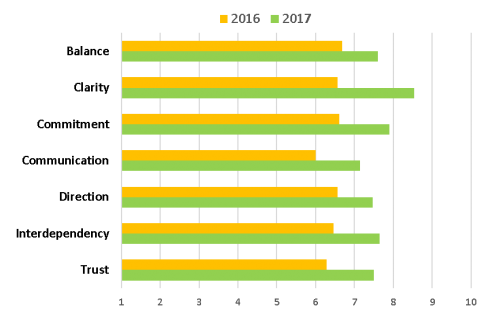
How Stramit lifted the roof on its business potential
In early 2016 when Paul Tudor took over the reins at Stramit, he faced a raft of urgent business challenges. Stramit was a problem child within Fletcher Building, Australasia’s largest building products group.
Despite being the second largest steel roll former in the Australian building supply industry, Stramit had been sliding backwards. Its market share had dropped five percentage points and most worrying of all, it had lost its sense of identity and direction.
The magnitude of the change needed became apparent in one of Paul’s first senior management meetings. In his leadership team he uncovered a group of individuals who had lost their way and endured a revolving door of general management.
“It was clear very early on that we needed a whole of business seismic shift in order to survive,” Paul reflects. “I knew we needed a sustainable customer-focused culture, starting at the top. Yet we couldn’t achieve this massive culture change without the top team being 100% aligned to a common purpose and without there being a seriously robust level of trust within the senior leadership team.”
“We needed to develop the top team’s soft skills, to unify and to become a single voice for the business. For my leadership team, it was about resilience when you have to make the tough calls, and it was about knowing your peers in the team have your back.”
“I felt strongly that in order to do the job, the senior management team would need to dig really deep and make enormous changes both individually and in how they operated as a team. From my previous experience I knew that we would need a combination of team coaching and 1:1 coaching, and that we would fail if we didn’t do the two together. The team work galvanises everyone, building trust and alignment. The 1:1 coaching develops the individual, providing a sounding board, new skills and the support framework needed for all members to achieve the transformation.”
Deep Understanding of the Issue
So how did the Top Team Intervention coaching work in practice?
In Stramit’s case, a number of key assessment tools provided the clarity and transparency required to plan a successful top team development initiative. These included Peoplescape’s High Performing Team survey, the Herrmann Brain Dominance Instrument (HBDI) and PeopleScape’s Leading for Performance and Wellbeing 360 degree assessment. Each instrument provided unique insights into team and individual effectiveness which formed the core around which specific coaching objectives were developed.
“We augmented the formal assessment with observations of the senior leadership team at work, to see them interacting with each other as well as in the wider business context,” explains Thomas Higgins, PeopleScape Director. These early insights were essential for shaping the most effective intervention for the Stramit Top Team.
Combining Team Development with Individual High Performance Coaching
Those who have worked through a significant change process will understand how very difficult it is to achieve this team shift without support; and how hard it is for individuals, particularly those in senior roles, to have the courage to try to change. The coach’s role is to provide the right structure and support – for both the team and the individuals.
PeopleScape’s Top Team Intervention is a specifically designed team development approach which combines work with the team and individual support via 1:1 high performance coaching. The Top Team Intervention is a stepped process to build working relationships with high levels trust and greater intimacy, so that management teams are equipped to work effectively together and deal with complex issues.
Thomas explains, “Teams shift because individuals shift. If a culture isn’t functioning to an optimal level, then the team needs to change, and this requires that individuals make changes. This can’t be achieved with one offsite workshop. It’s a process to develop the high level of trust that allows people to experiment and change in ways that are lasting.”
The Outcomes
Today Stramit is a business with a very different culture, achieved in a relatively short time-frame. The business now has the right people in the right roles and a level of trust that allows the heavy lifting required to achieve the business mission.
As shown below, all critical ingredients for a true high performing team, self-assessed by Stramit Executive Team members, improved dramatically as a result of systematic combined individual and team coaching.
Along the transformation path, the team and the individuals have changed significantly and for some, this has meant leaving Stramit. Paul adds, “We now have top team cohesiveness. We are powerful, we are harmonised, we are transparent. We can have the difficult conversations honestly, challenge each other respectfully and then get on with the job of delivering our mission. We are committed to our customers and our customer focus. And the combined approach of team and 1:1 coaching provided by PeopleScape has been integral in our success.”
“We launched our cultural shift by announcing our ‘Declaration of Done’, our commitment to our customers and to customer service. Our declaration is that we will get the job done, and if we don’t, we have defined and clearly stated consequences. Internally this was frightening for many at first. But our first win, where we delivered on our promise, was incredibly impactful for the whole business. The declaration, the commitment and the achievement really kick-started the business-wide cultural change and captured hearts and minds at all levels.”
The impact of the top team intervention has filtered down through the business and helped reverse a disengaged and rudderless workforce. The momentum continues to build, with the recent introduction of scoreboards, re-branding and much greater sharing of information at all levels of the business.
“This year our EBIT grew by 32%. For the first time in six years our market share grew and our employee engagement score also improved. We are now seen as a leader in the Fletcher Building Group and we are delivering on our customer promises.”
“In the past it had seemed too hard, but now we have a sense of purpose. We are much more match-fit. Despite major headwinds – major market pressures and extreme weather events to name just two – we have a growing pace of change and the whole business is working with a real sense of urgency. From being a business unit that was lacking a future, Stramit is now seen as a rising star – something I am extremely proud of.”
Taking the Top Team Development Challenge
Combining a Top Team Intervention approach with high performance 1:1 coaching provides senior executives with the ingredients, capabilities and tools to achieve so much more than the sum of the parts. It equips teams to tackle difficult business challenges and to build long term business value.
“The idea that high performing teams just happen, without consistent hard work and focus, is just not realistic,” says Thomas. “Invariably, high performing teams treat their own performance as paramount. They bring managing themselves and tending to their own capability development to centre stage, in the same way as they manage and monitor other core functions of the business.”

